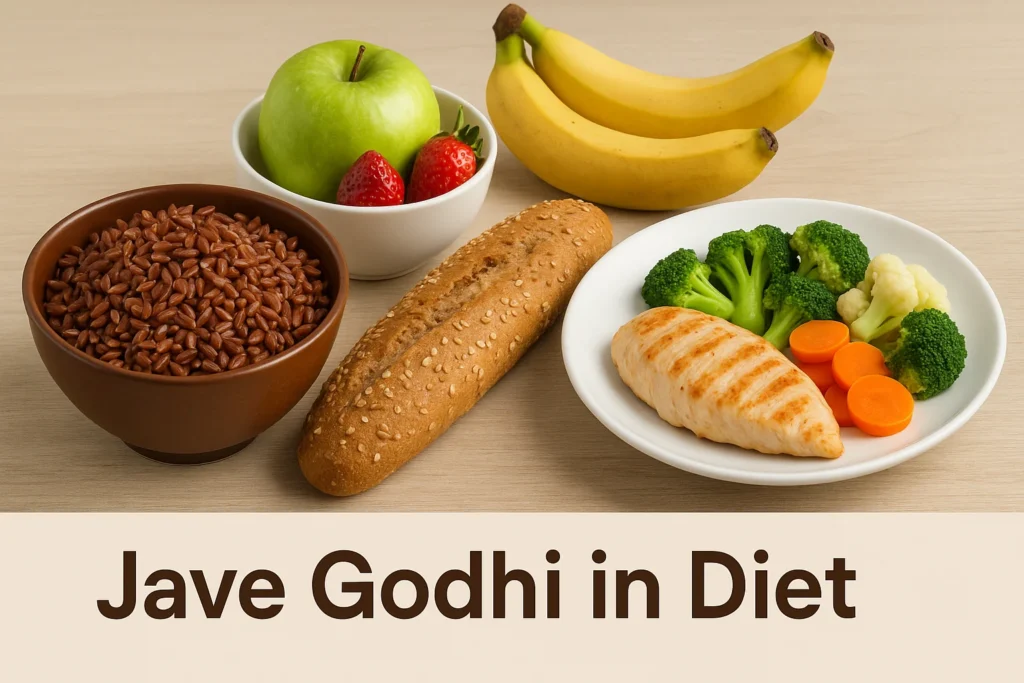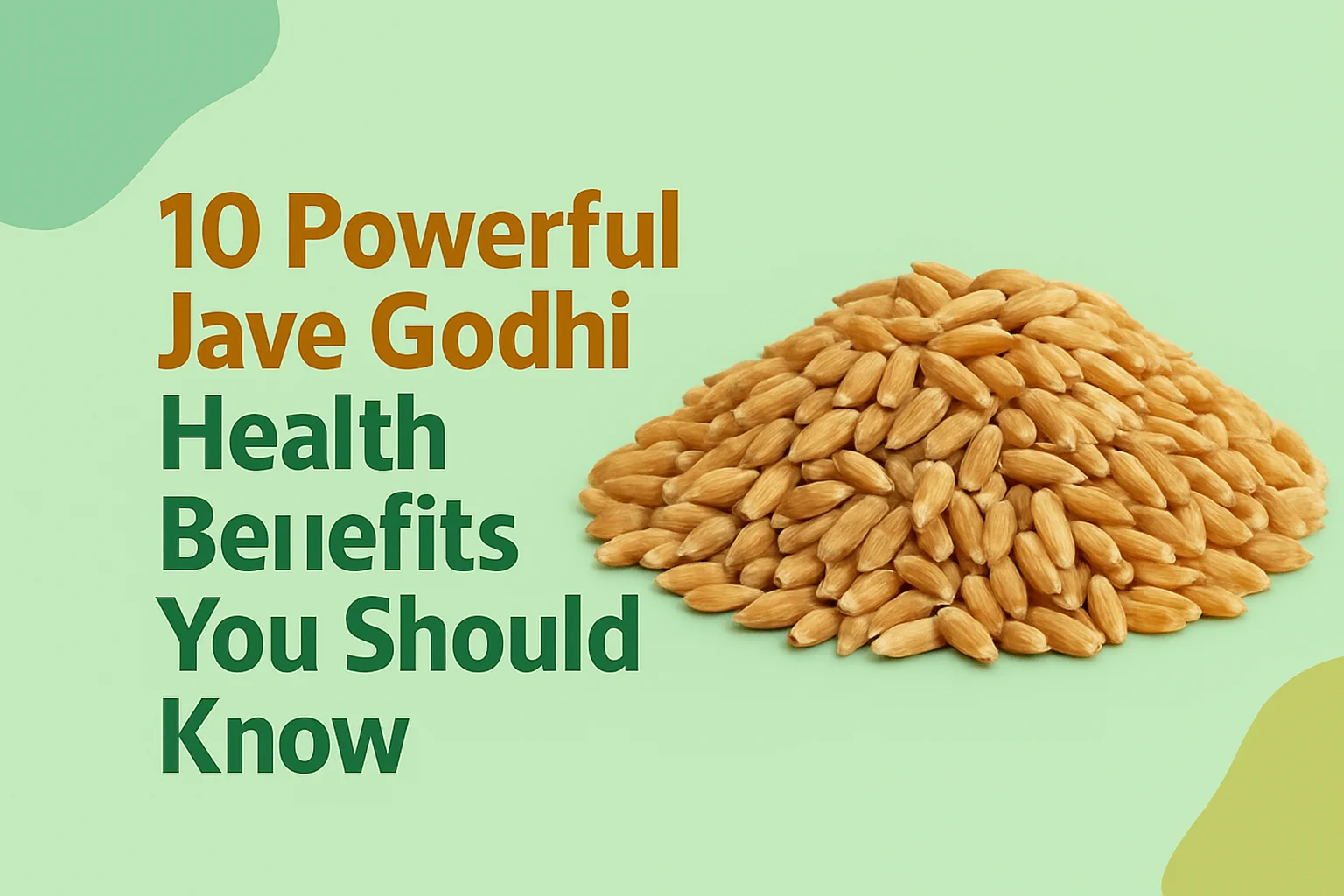In recent years traditional Indian grains have gained immense attention for their health benefits. One such underrated grain is Jave Godhi also known as broken wheat or cracked wheat. Derived from whole wheat kernels that are cleaned, husked and coarsely ground, Jave Godhi is packed with essential nutrients. Whether you’re trying to lose weight, manage diabetes or simply improve your overall health, this grain is a nutritional powerhouse. In this article, we will explore 10 powerful Jave Godhi health benefits you should know and how including it in your daily meals can contribute to a healthier lifestyle.
1. Rich Source of Dietary Fiber
One of the most well-known jave godhi health benefits is its high fiber content. Being minimally processed, it retains most of its bran and germ. This makes it an excellent source of both soluble and insoluble fiber.
Why is this important?
- Soluble fiber helps lower bad cholesterol levels.
- Insoluble fiber improves digestion and prevents constipation.
For example, a bowl of jave godhi upma or porridge in the morning can help you stay full for longer reducing the urge to snack unnecessarily.
2. Supports Weight Loss Goals
If you’re trying to shed some kilos including Jave Godhi in your diet can be a game changer. Its high fiber content promotes satiety, which means you feel full for longer periods. This naturally leads to reduced calorie intake throughout the day.
Additionally, Jave Godhi has a low glycemic index (GI), which ensures that your blood sugar levels remain stable and reduces fat accumulation. Among all jave godhi health benefits, this one is particularly appreciated by fitness enthusiasts and those on weight loss journeys.
Try replacing white rice or refined wheat with jave godhi in dishes like khichdi, pongal, or pulao.
3. Excellent for Diabetic Management
Managing diabetes can be difficult especially when it comes to carbohydrate intake. Unlike refined flour and white rice, Jave Godhi releases glucose into the bloodstream slowly preventing sudden spikes in blood sugar.
This makes it a great alternative for diabetics. In fact, regular consumption of Jave Godhi has been linked with better glycemic control and improved insulin sensitivity.
For example, a diabetic-friendly dish like Jave Godhi vegetable upma or pongal is both nourishing and safe.
4. Heart Health Booster
A healthy heart starts with what you eat. The dietary fiber, magnesium and antioxidants in Jave Godhi contribute to improved cardiovascular health.
Here’s how:
- Fiber lowers LDL cholesterol levels.
- Magnesium supports healthy blood pressure.
- Phytonutrients in whole wheat reduce oxidative stress.
Including Jave Godhi in your diet can lower the risk of heart diseases, especially if you replace processed foods with it. This is one of the key jave godhi health benefits that long term health planners swear by.
5. Improves Digestive Health
Jave Godhi is a natural remedy for various digestive issues, thanks to its rich fiber content. It adds bulk to your stool and ensures regular bowel movements, preventing constipation.
Moreover, it acts as a prebiotic – feeding the good bacteria in your gut. A healthy gut microbiome supports not just digestion but also immunity and mental clarity.
Among the numerous jave godhi health benefits, improved digestion is perhaps the most immediate and noticeable change people experience.
6. Rich in Iron – Helps Prevent Anemia
Another lesser-known advantage of Jave Godhi is its iron content. Iron is important for the production of hemoglobin in the blood. Iron deficiency can lead to fatigue, weakness, and anemia.
Regular consumption of iron-rich foods like Jave Godhi can help improve blood count and energy levels, especially in women and children.
One of the holistic jave godhi health benefits is that it supports better oxygen circulation and keeps tiredness at bay.
7. Bone Health and Strength
Jave Godhi contains essential minerals like magnesium and phosphorus, both of which are crucial for maintaining healthy bones and teeth. These minerals aid in bone formation and help prevent conditions like osteoporosis in older adults.
If you’re aiming for long term skeletal strength including Jave Godhi in your meals 2–3 times a week can make a difference.
This makes it a practical and accessible way to enjoy jave godhi health benefits related to skeletal development and aging support.
8. Improves Skin Health
Yes, you read that right! Your skin is a reflection of your internal health. The presence of antioxidants, vitamins like B-complex and zinc in Jave Godhi helps detoxify the body and keep the skin glowing.
Jave Godhi also promotes better digestion, which in turn reduces skin breakouts, acne and dullness. It’s not a miracle ingredient but when consumed regularly, it contributes to a naturally healthy complexion.
Many users have reported clearer and more radiant skin after switching to traditional whole grains like Jave Godhi. That’s why it is now gaining popularity in beauty conscious circles for its benefits related to skin.
9. Provides Long-Lasting Energy
Unlike simple carbohydrates that give you a quick spike of energy followed by a crash, Jave Godhi releases energy slowly. This means sustained stamina throughout the day, making it an ideal breakfast or lunch option.
It’s particularly beneficial for:
- Athletes
- Working professionals
- Students
- Elderly individuals who need sustained energy without feeling heavy
This energy balance is one of the top jave godhi health benefits, especially when planning balanced, energizing meals.
10. Versatile and Easy to Include in Meals
Lastly, a practical benefit – Jave Godhi is incredibly versatile. You can make upma, khichdi, porridge, pulav, pongal, and even sweet dishes like godhi payasa. It blends well with vegetables, dals, and spices, making it a perfect fit for Indian meals.
Because it’s easy to digest and suitable for all age groups – from toddlers to elders – it can become a staple in your family’s weekly meal plan.
The ability to prepare healthy and tasty dishes while reaping jave godhi health benefits makes it a favorite among traditional food lovers.
Also Read: Jeeni Health Mix Benefits
How to Include Jave Godhi in Your Daily Diet

Understanding the jave godhi health benefits is one thing, but knowing how to incorporate it into your everyday meals is equally important. Fortunately, Jave Godhi is incredibly versatile and can be used in both traditional and modern recipes.
Here are some easy and healthy ways to add it to your diet:
- Breakfast: Use Jave Godhi to make upma, porridge or a savory pongal.
- Lunch/Dinner: Replace rice with Jave Godhi in pulao, bisibele bath, khichdi or curd rice.
- Snacks: Prepare godhi cutlets or steamed godhi idlis for healthy bites.
- Sweets: Make godhi payasa (kheer) with jaggery and coconut milk for a guilt-free dessert.
You can batch cook it and store it in the fridge for 2–3 days, making it an easy, healthy base for quick meals. When consumed consistently, these meals can help you enjoy the full range of jave godhi health benefits.
Traditional Importance and Ayurvedic View
In Ayurveda and traditional Indian diets whole grains like Jave Godhi have always held a special place. It is classified as saatvik food — clean, nourishing and balancing in nature.
According to Ayurveda:
- Jave Godhi is tridoshic — it can help balance Vata, Pitta and Kapha when cooked appropriately.
- It is recommended for people with weak digestion, especially when made into a soft porridge with ghee.
- The warmth and grounding nature of Jave Godhi make it ideal for boosting Ojas, the vital energy in the body.
Including foods with deep traditional roots not only offers physical nourishment but also promotes harmony between the body and mind. This adds a cultural and spiritual dimension to the jave godhi health benefits, reinforcing why it’s been consumed for centuries in Indian households.
Final Thoughts
To sum it up Jave Godhi health benefits are wide ranging and impactful. It’s more than just a grain – it’s a functional food that supports your body from the inside out. Whether you are trying to lose weight, manage blood sugar, improve your digestion or boost your energy, Jave Godhi can be a valuable addition to your diet.
Instead of relying on processed grains and ready-to-eat meals, going back to basics with this time-tested ingredient can bring you long-term health rewards. The best part? It’s affordable, easily available, and deeply rooted in Indian cuisine.
So why wait? Start exploring recipes with Jave Godhi today and unlock the many benefits it offers.
Frequently Asked Questions
1. Can I eat Jave Godhi every day?
Yes, Jave Godhi can be eaten daily as a replacement for refined grains. It’s gentle on the stomach and promotes digestive health.
2. Is Jave Godhi good for diabetes?
Absolutely. It has a low glycemic index, which helps control blood sugar spikes and is beneficial for people with diabetes.
3. Can pregnant women consume Jave Godhi?
Yes, the high fiber and iron content make it a great choice during pregnancy. However, it’s always good to consult a doctor before making dietary changes.
4. Is Jave Godhi gluten-free?
No, Jave Godhi is made from wheat and contains gluten. It is not suitable for those with celiac disease or gluten intolerance.
5. How do I cook Jave Godhi?
You can cook it like rice or semolina. It can be used in recipes like upma, porridge, or khichdi by boiling it with water and spices.




